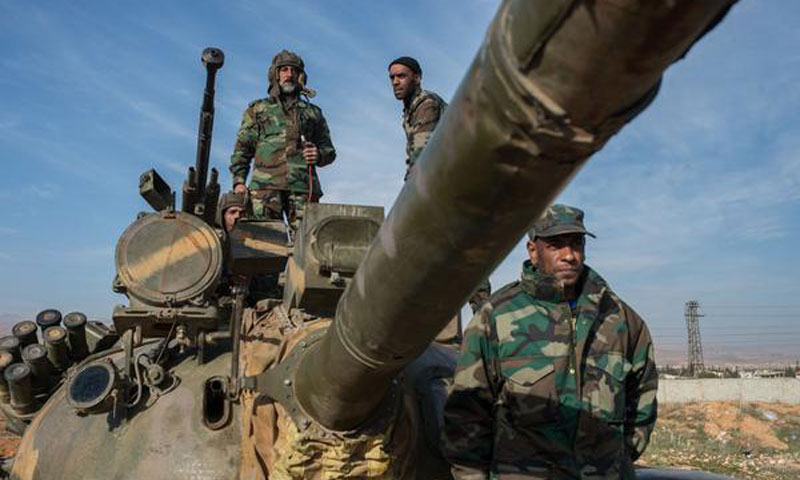Enab Baladi-Special
The days of the Damascus International Fair, which is held on the outskirts of the capital Damascus are coming to an end, after 10 days of economic activities during which the Syrian regime wanted to present the capital as a “stable and secure area”.
Returning to the early years of the Syrian revolution in the vicinity of the capital Damascus, Fairgrounds, which contained the exhibition, witnessed a military clash between the “Free Army” factions and al-Assad forces, after the free Army made progress on the Damascus International Airport road and took control of “strategic” areas, trapping al-Assad then.
As a result of developments that reached their peak at the beginning of 2013, the exhibition was finally closed for nearly five years, until August. It is now returning for its 59th session, away from any actual military threat.
Enab Baladi tells the story of the strategic and military actions that took place in the airport road area starting from the domination of the opposition factions, to the dominance of al-Assad forces and the militias supporting him.
2013: The Year of the Free Army Domination
The period which extends from September 2012 to February 2013 was a golden stage for the factions in Damascus countryside, as they succeeded in forming a crescent that surrounded the capital from three sides (the western, southern and eastern). The area which stretches from Muadamiyat al-Sham region in western Ghouta to Adra in eastern Ghouta has become dominated by the opposition.
The opposition then succeeded in putting its hands on large parts of Damascus International Airport by controlling the towns of Chebba and Hutajtat al-Turkmen with both being opened to the vital road. It also succeeded at narrowing its docks on the airport by increasing its influence in its two neighboring towns of Harran al-Awamid and Ghizlaniyah. The opposition has already begun to infiltrate the area by targeting the airport with artillery and missiles. However, they didn’t succeed.
Hutajtat al-Turkmen, which was controlled by the factions, formed the port and the last gateway to Damascus International Airport. The armed opposition operating in the area turned it into a launching pad for their attacks on the locations of al-Assad forces deployed on the airport’s road between the fourth and sixth bridges.
It was also a point of spread from deep eastern Ghouta towards the main airport road.
The opposition factions broke into Sham Village Resort which is situated on the airport road, near the seventh bridge to Ghasula village. They showed video recordings from inside the resort, which is located next to the Fairgrounds, something that was considered as a major military strike against the Syrian regime at that time and showed poor military coordination in the vicinity of the “strategic” International airport, which then became a direct target of the opposition strikes.
A Battle by Al-Assad Secured the Way
Ghasula village was the last point in the opposition factions’ progress. Within days of the significant progress that was achieved, al-Assad forces and its supporting “Hezbollah” militias launched a military counterattack in order to secure the road to the international airport and the surrounding areas.
The al-Assad forces re-appropriation of al-Sabinah area in southern of Damascus in November 2013 represented a landmark turning point in Damascus and its countryside. Within a month, the cities and towns of Ghouta fell like dominoes, most notably al-Bouwayda, al-Hadjira, Chebba, Hutajtat al-Turkmen, Ghizlaniyah, Harran al-Awamid, Otaybah, Abbadeh, al-Qisah and Der Salman.
The factions also lost al-Malihah town in deep Ghouta as well as Adra city, together with its houses and industrial zone in the north in August and September 2014.
The Syrian regime achieved two goals through this process that he has been seeking to achieve: the first was to secure the road between Damascus and the international airport to the eastern side, and the second was a complete separation of eastern and western Ghouta, isolation of the southern area of Damascus, and then besiege of the three areas as the upcoming stage, in order to target each region separately, and to force the factions to accept truce and reconciliations.
After the regime ended the mission of al-Malihah town, which is close to the airport and is five kilometers away from the capital, in August 2014, reconciliations were held in the towns of Aqraba, Chebba, Hutajtat al-Turkmen and al-Husayniyah, which was another justification for the need to secure the vital road.
Assad’s military operations were not limited to the villages adjacent to the airport only, but they extended beyond. Al-Assad forces took control of Deir al-Asafir, Bala farms, ancient Bala, Zabdin and Nola, to cut off for good the opposition’s dream of reaching the main nerve of the airport.

